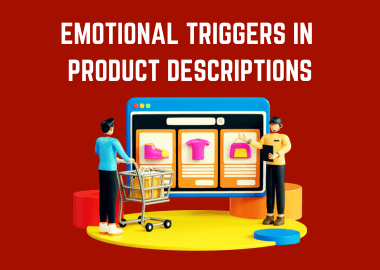
Product descriptions can make or break an online product’s sales.
Don’t believe us?
Consider this: what’s the first thing that catches your attention when shopping online? Product images, right?
But what holds your attention and drives your decision to buy the product? More often than not, it’s the product description!
In fact, a study by eMarketer reveals that 82% of ecommerce shoppers claim product descriptions influence their purchase decisions:

The best product descriptions connect with the audience on an emotional level. They feature the right emotional triggers to drive customer action.
An impactful product description empathizes with the target buyer, solves their pain points, and helps them envision the product in use through powerful copy that elicits the right emotions.
Let’s explore how you can use emotional triggers in your product description to foster a deep connection with your target audience!
Table of Contents
What Are Emotional Triggers in Digital Advertising?
Emotional triggers are psychological cues used in marketing content, digital advertising, and persuasive copywriting to prompt a specific response or reaction from the target audience.
These triggers are often tied to human emotions and can vary widely from person to person. Common emotional triggers can include various techniques, such as using:
- Humor
- Joy
- Sadness
- Fear
- Trust
- Nostalgia
- Empathy
By understanding these triggers and their role in crafting a product description, you can tap into your target consumer’s emotions and behavior, compelling them to buy your offering.
Product Descriptions That Drive Conversions
CDP’s experienced writers can write high-quality, original, and effective product descriptions with emotional triggers that will boost your sales!
7 Ways Emotional Triggers in Product Descriptions Drive Action
Let’s explore how brands use emotional triggers in their product descriptions to connect with their target audience and encourage action:
The Power of Storytelling
One of the most effective ways to incorporate emotional triggers into product descriptions is through storytelling. After all, who doesn’t love a good story?
Instead of presenting a list of features, businesses can weave a narrative that humanizes the brand and resonates with their target audience and evokes the right emotions.
For example, a clothing brand could describe the journey of creating a particular garment, highlighting the craftsmanship, attention to detail, and the passion of the designers.
See how Laithwaites Wines crafts this story in their product description that successfully evokes a sense of wonder and excitement and informs the reader about the origins of the wine:
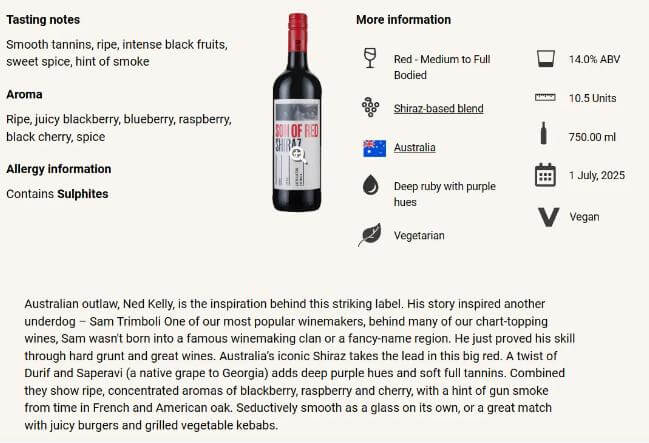
When crafting your story, use vivid language, sensory details, imagery, and words that paint a detailed picture. Make the story relatable and honest.
Check how Weber sets the stage in this story-like product description example, helping the reader imagine what it would be like to own its grill:
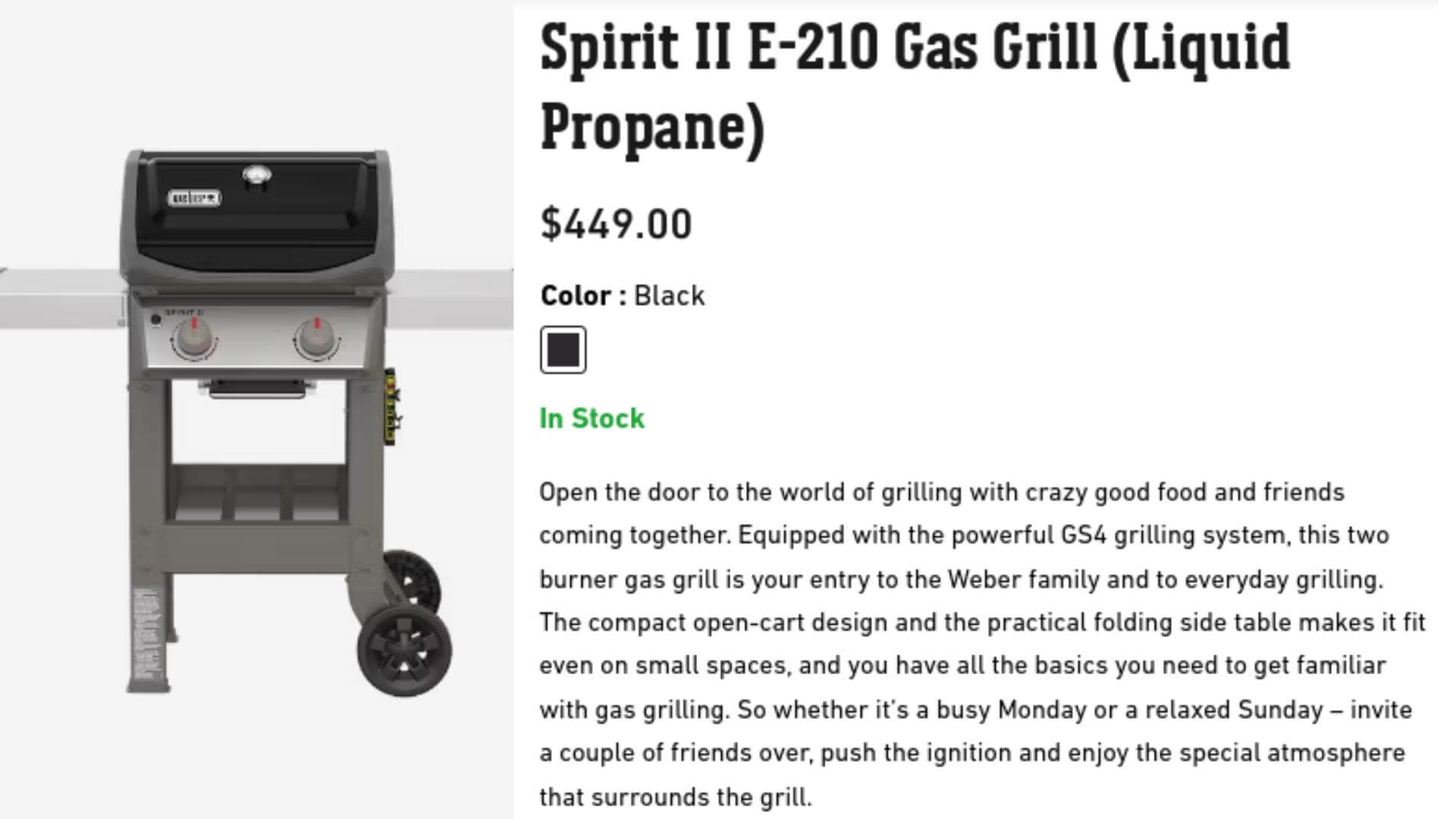
When crafting a story in your product description, think of what would spark the buyer’s imagination, trigger the right emotions, and solve their pain points.
Appealing to Aspirations and Desires
Emotional triggers are closely tied to the aspirations and desires of consumers. Ecommerce sites that use product descriptions that speak to these aspirations are able to influence purchasing decisions.
For instance, a fitness product could highlight the potential for transformation and the fulfillment of personal goals.
By tapping into the customer's desire for self-improvement and achievement, a fitness brand can create a sense of connection and relevance.
An aspiration or desire can be as small or as lofty as possible. Consider Hermes, a world-renowned luxury brand with products that represent the utmost luxury.
The brand is known for timeless designs and exorbitant prices. Hermes cashes that price tag to maintain its allure and targets customers that aspire to own luxury brands.
Here’s the perfect product description example that highlights the lofty language Hermes uses for an air of refined luxury its target audience craves:

Hermes doesn’t just use poetic language to attract its audience. It also employs the power of storytelling on its product pages to share the origins of its jewelry with interested buyers:

It’s an effective strategy: use the products page for aspirational language and keep the individual product pages for the origin story and product specifications.
Addressing Customer Pain Points
Product descriptions that address the needs, problems, and worries of the target audience use carefully selected language in their copy.
For instance, the description of a supplement for gut health should address the burning pain or other complications the target buyer might experience in their gut.
Kong, a leading producer of dog toys and more, masterfully uses copy that addresses customer pain points:
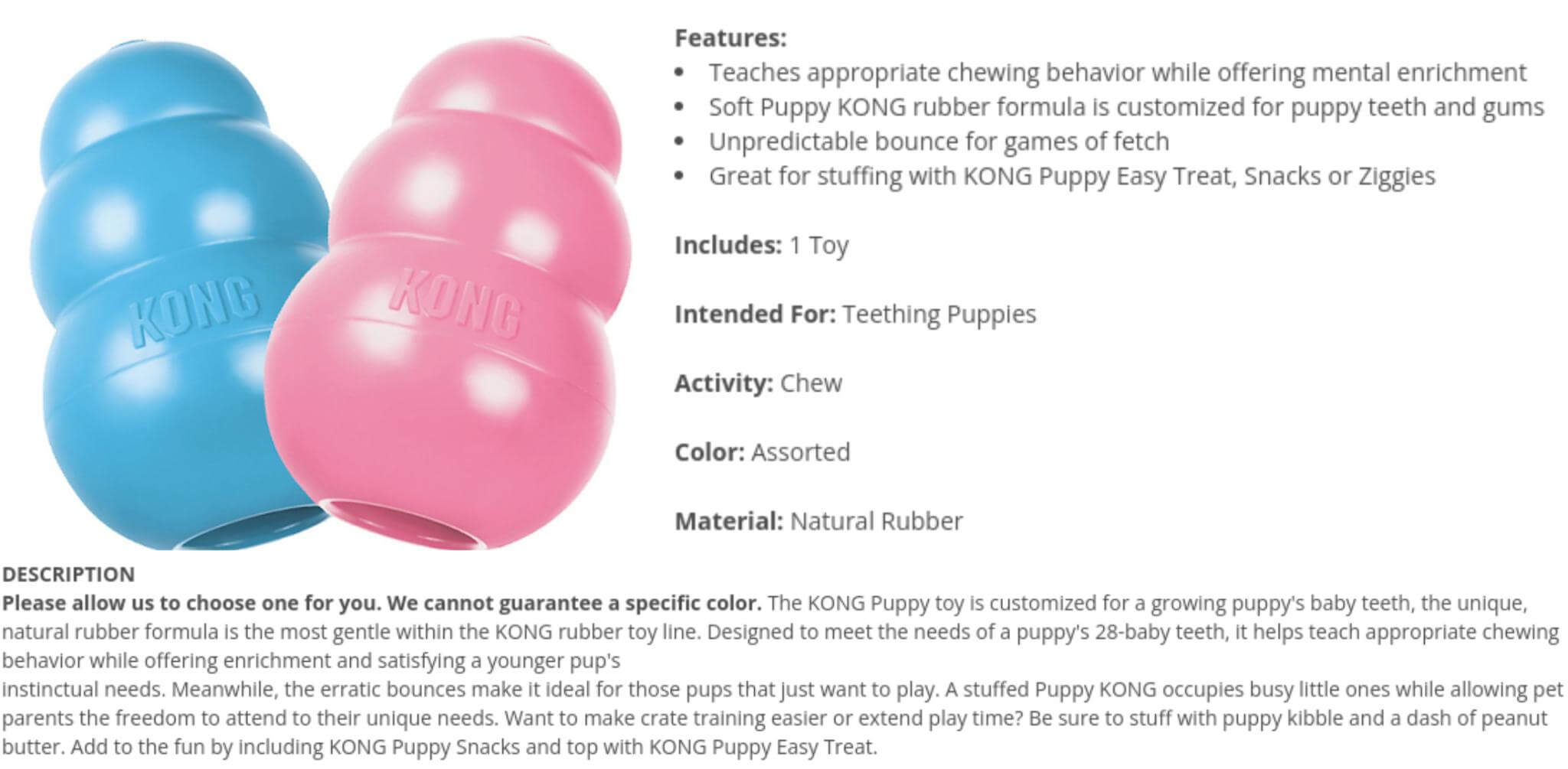
While we all love cuddly puppies, most people who own them have to constantly worry about the adorable menaces chewing everything.
It’s why Kong’s product description is so effective. It seamlessly covers the primary pain point of its target buyer, i.e., teething puppies.
The description of the treat-dispensing chew toy includes features and benefit-related phrases that solve the buyer’s problem, such as “teaches appropriate chewing behavior” and “offers mental enrichment.”
Similarly, Dove’s classic product description example solves the buyer’s pain point instead of merely talking about the shampoo’s features:

The shampoo’s description focuses on addressing hair fall, the primary pain point of the target buyer. It offers the right solution and backs its claim with a statistic to build buyer trust.
Turning Product Features into Benefits
The best way to ignite your customer’s interest in your products is to take the product’s unique features and write them as compelling benefits for the target audience.
Think about everything that excites you about the product and how it’s designed to help your target users. It will help you come up with your product’s USP and other benefits.
When you list features as benefits, your copy connects with the reader and enables them to visualize how the product will help them, triggering the right emotions and actions.
Consider this product description example by Method that highlights the benefits of using its glacier+granite body wash:
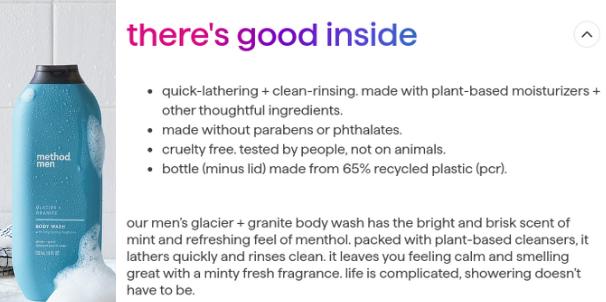
Method’s product description focuses on what the customer will gain from its body wash, appealing to their needs and desires.
Creating a Sense of Exclusivity
People are naturally drawn to things that feel exclusive or unique. Businesses can leverage this by using emotional triggers that evoke a sense of exclusivity in their product descriptions.
Limited edition releases, personalized touches, or unique features can create a feeling of privilege among customers.
Expressing scarcity or exclusivity can tap into the fear of missing out (FOMO), encouraging customers to make a purchase to be part of an exclusive group.
Apple doesn’t need an introduction. Its products speak for themselves. The brand is also credited for having highly impactful product descriptions that reflect the art of creating exclusivity effortlessly.
This effortlessness is evident in this Apple product description example of its smartwatch series:

While the introduction to the product is simple, sleek, and highly effective in creating a sense of exclusivity, the real impact comes through the longer description on the product page:

These are three instances in which Apple emphasizes on the exclusive nature of its product on the page. It helps the buyer envision themselves as the owner of a newer, better, and more environmentally-friendly product from the tech giant.
Building Trust and Reliability
Trust is a crucial factor in any consumer-business relationship. You can employ emotional triggers to build trust by emphasizing qualities such as reliability, authenticity, and transparency.
A product description that highlights ethical practices, quality assurance, and customer testimonials contributes to a positive emotional connection.
When customers feel they can trust a brand, they are more likely to make a purchase and become loyal advocates.
Casper is an expert at building trust by using social proof and compelling images in its product copies. Here’s a prime product description example the brand uses for its popular mattress:
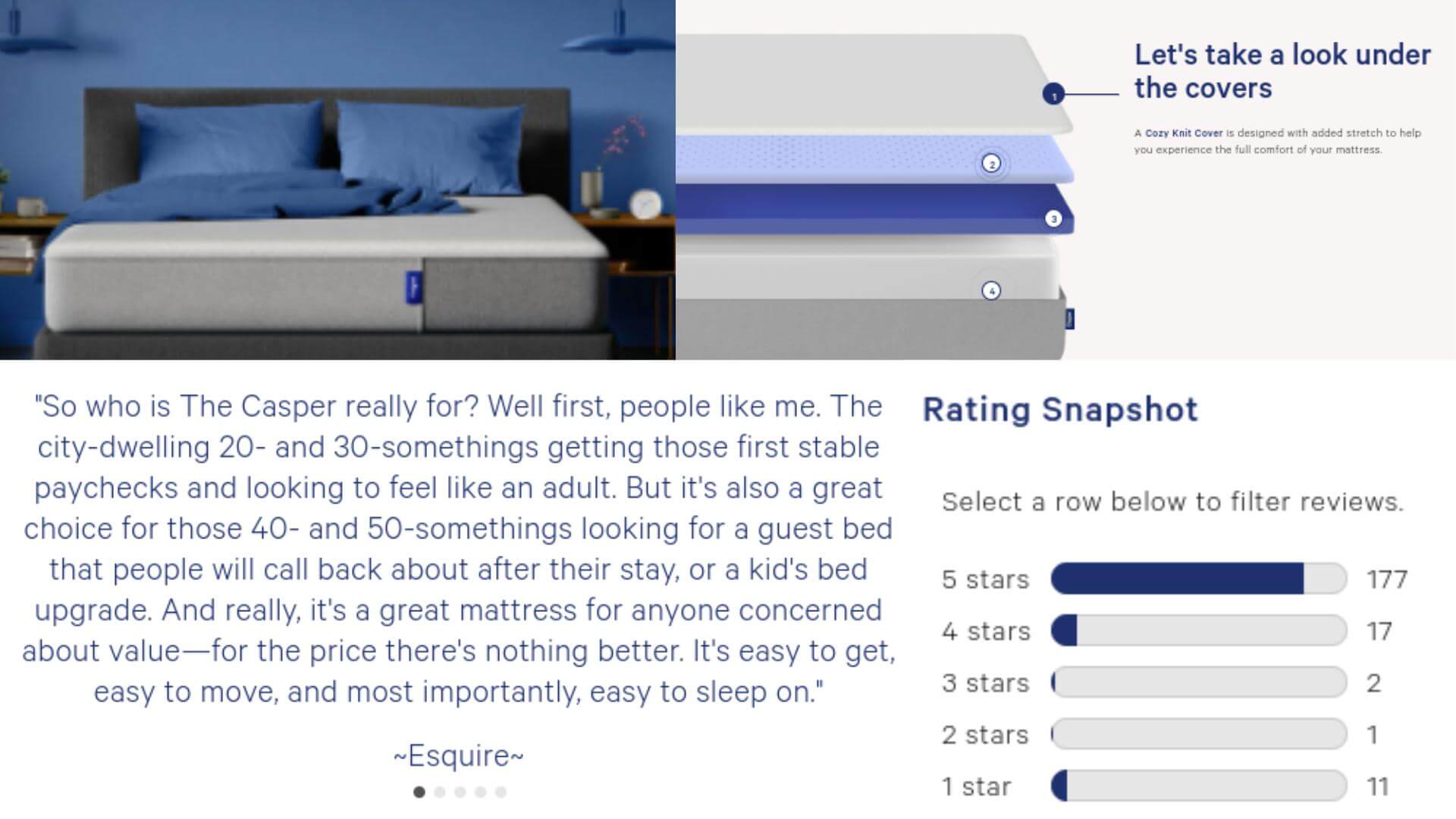
Each of Casper’s mattress pages have customer testimonials, a comprehensive ratings section, and visually appealing pictures that instill confidence in the target buyer.
Since many people hesitate to buy mattresses online without testing them, the reviews and pictures ease customer worries and hesitation and increase the likelihood of conversions.
The Impact of Visual Elements
The visual elements of product descriptions play a significant role in triggering emotions. High-quality images, videos, and graphics can complement the written content, enhancing the overall emotional appeal.
Visual elements can convey the product's usage in real-life scenarios, showcase its benefits, or evoke specific emotions that align with the brand's message.
Going back to the example of Weber grills, the same product description features visual aids along with persuasive copy to connect with the reader and encourage the desired action:

These visuals represent the distinct features and their corresponding benefits of the grill. They help the buyer visualize the benefits, increasing the chances of conversions.
Casper also does a wonderful job of using images along with persuasive copy to compel the target audience to buy its mattresses.
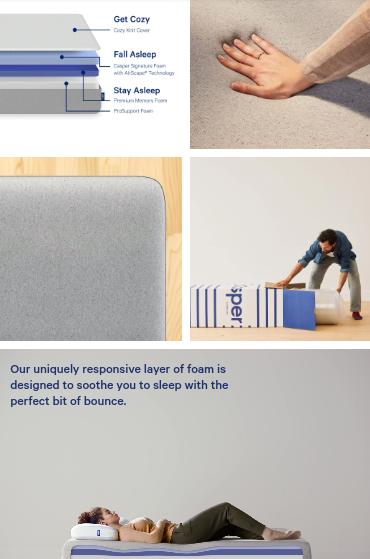
These visuals help the target buyer see what it would be like to sleep on a Casper mattress and the benefits they will get out of it.
Do Emotional Triggers Work in Product Descriptions?
In the online shopping realm, where customers lack the physical interaction with products, the role of emotional triggers in product descriptions becomes paramount.
By understanding the psychological factors that influence consumer behavior, businesses can create compelling stories and product copies that resonate with their target audience.
Through the aforementioned ways of incorporating product descriptions, businesses can forge a deeper and more meaningful connection with customers, ultimately driving engagement and boosting sales.
CDP - Premium Product Description Writing Service
At CDP, we create professionally-written, conversion-optimized product descriptions with the right emotional triggers and keywords.
With our product description writing service, you get descriptions that are:
- 100% original and conversion-focused
- Tailored to your requirements
- Optimized for your chosen platform
Our product description writers have ecommerce writing experience and search optimization and marketing expertise. They understand the nuances and value of emotional triggers in product descriptions and can produce high-quality product copies quickly.
Starting From Only $1/Product Description!
